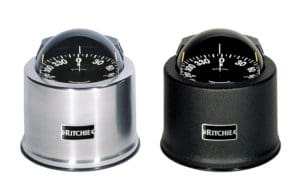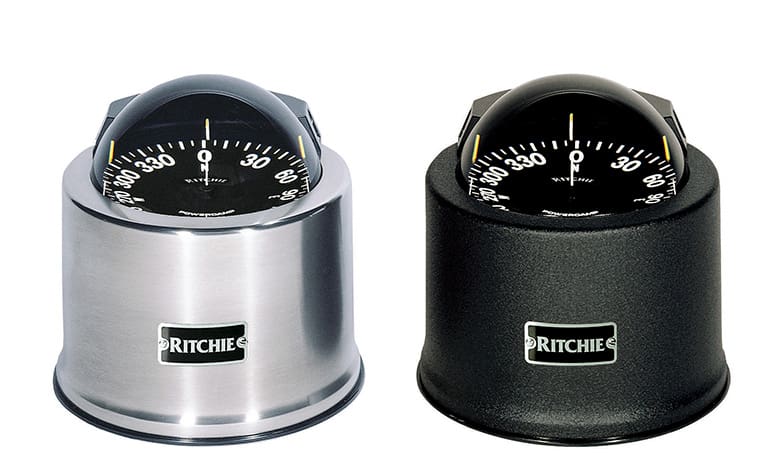
In a world of GPS and LCD screens that can display any navigation parameter possible, does the floating-card magnetic compass still make sense? To pose the question is in a sense to answer it, so let’s look at the value a magnetic compass provides to the voyager.
In addition to the classic magnetic compass, for some time now voyagers have had electronic versions of the compass. The most common of these being the magnetic fluxgate. While fluxgates use electronic signal processing to provide a readout of direction to the user, at their heart they determine direction by sensing the earth’s magnetic field directly.
As with all things navigation, GPS changed the concept of the compass itself with something called the GPS compass. This device typically uses multiple GPS antennas in a horizontal array and determines vessel orientation by comparing the outputs from the various antennas and how they are changing over time. They are a high-tech approach to determining heading. Non-electronic magnetic compasses provide heading by sensing the earth’s magnetic field, like a fluxgate. But they do so without any electricity — being driven by the interaction between magnets and the global magnetic field. This feature makes a magnetic compass a great backup device should your boat lose electrical power.
The classic, liquid-filled magnetic-card compass was largely invented by American instrument maker and inventor E.S. Ritchie in the 1860s. Prior to Ritchie, the dry card compass, with no liquid to dampen the movement of the card, was the standard compass used by mariners. Ritchie, however, made substantial improvements in adding a liquid and making other tweaks. As a result, Ritchie’s design became the new standard for the U.S. Navy and beyond.
The Ritchie Navigation company in Pembroke, Massachusetts still makes classic magnetic compasses that are based on E.S. Ritchie’s breakthrough model. To get an idea of what goes into one of these instruments I talked to Patrick Lonergan, director of quality and engineering at Ritchie.
According to Lonergan, there’s a key to making a good compass: “It’s all about balance.” In the case of the compass, part of the balance is making the compass card neutrally buoyant so it neither floats nor rides too hard on its pivot point.
The fluid in a compass supports the card and provides a viscous medium to support its movement. Because compasses live out in the environment, they must work properly in a range of temperatures without freezing or forming a gas bubble that affects card readability and card response. In previous decades a mixture of alcohol and water and later mineral spirits was used. Current Ritchie compasses use a paraffin-based liquid called isopar L. As good as this material is at remaining stable, it is helped by a diaphragm system that expands and contracts with temperature changes so a bubble doesn’t form. According to Lonergan, the diaphragm system will prevent bubble formation down to minus 30° F.
Riding on the underside of the card are magnets made of an alloy called alnico (iron with amounts of aluminum, nickel and cobalt). These magnets interact with the earth’s magnetic field. The key to a compass is using the right magnet. “You want to match the magnet strength to the dial,” Lonergan said. “You don’t want the magnet to be too strong or the card will overshoot.”
Also on the underside of the card are baffles that are tuned to dampen the motion of the card through the fluid. At the center of the card is a steel pin, the point of which rests on a central post containing a piece of industrial sapphire. This man-made jewel is extremely hard and supports the steel pin with minimum wear.
So the balancing act here is clear: the fluid must be of the right viscosity to slow the card without too severely limiting its reaction time; the baffles must be tuned to work with the isopar L but again not provide sluggishness or overshoot; the card must be made to rest lightly on the jewel bearing but not so lightly that it floats; and the diaphragm system must compensate for temperature and pressure so that the liquid doesn’t get too thick or form a bubble. Ritchie Navigation calls this set of balances its Powerdamp system and it is available on models like the Globemaster series of compasses, well suited to voyaging sailboats and trawlers. For high speed power vessels Ritchie offers a package called Powerdamp Plus.
A classic magnetic compass not only operates without electricity, but it also senses the geomagnetic field directly without any delay. “A magnetic compass is providing real time heading information,” Lonergan says. “GPS-based systems can’t do that.” n

